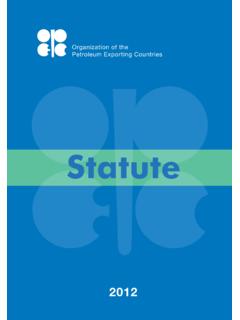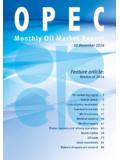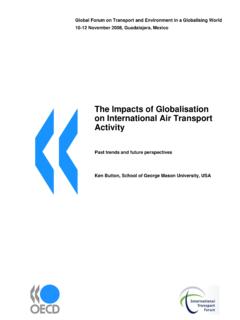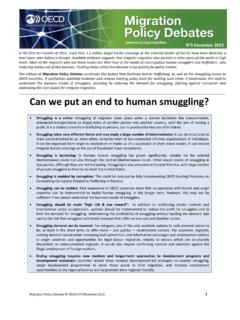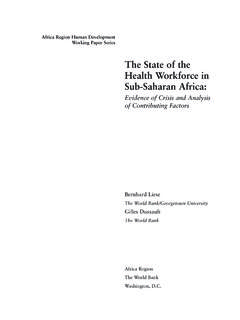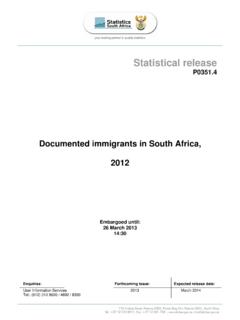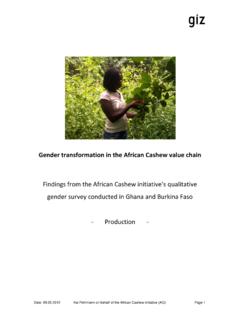Transcription of ED IT O N World Oil Outlook - OPEC
1 WorldOilOutlook2016 Organization of the Petroleum Exporting CountriesEDITIONW orldOilOutlook2016 Organization of the Petroleum Exporting CountriesOPEC is a permanent, intergovernmental organization, established in Baghdad, Iraq, on 10 14 September 1960. The Organization comprises 14 Members: Algeria, Angola, Ecuador, Gabon, Indonesia, the Islamic Republic of Iran, Iraq, Kuwait, Libya, Nigeria, Qatar, Saudi Arabia, the United Arab Emirates and Venezuela. The Organization has its headquarters in Vienna, Austria. OPEC Secretariat, October 2016 Helferstorferstrasse 17 A-1010 Vienna, Austria 978-3-9503936-2-0 The data, analysis and any other information ( Content ) contained in this publica-tion is for informational purposes only and is not intended as a substitute for advice from your business, finance, investment consultant or other professional.
2 Whilst reasonable efforts have been made to ensure the accuracy of the Content of this publication, the OPEC Secretariat makes no warranties or representations as to its accuracy, currency or comprehensiveness and assumes no liability or responsibility for any error or omission and/or for any loss arising in connection with or attributable to any action or decision taken as a result of using or relying on the Content of this publication. This publication may contain references to material(s) from third par-ties whose copyright must be acknowledged by obtaining necessary authorization from the copyright owner(s). The OPEC Secretariat will not be liable or responsible for any unauthorized use of third party material(s). The views expressed in this pub-lication are those of the OPEC Secretariat and do not necessarily reflect the views of individual OPEC Member material contained in this publication may be used and/or reproduced for educa-tional and other non-commercial purposes without prior written permission from the OPEC Secretariat provided that the copyright holder is fully citation: Organization of the Petroleum Exporting Countries.
3 2016 OPEC World Oil Outlook . October 2016. Available from: : All the data presented in this Outlook is available at , Energy Studies DepartmentIn Charge of Research DivisionOswaldo Tapia SolisAuthorsJan Ban, Jorge Le n Arellano, Amal Alawami, Roberto F Aguilera, Martin TallettContributorsMoufid Benmerabet, Harvir Kalirai, Julio Arboleda Larrea, Hans-Peter Messmer, Mohammad Taeb, Eleni Kaditi, Haris Aliefendic, Erfan Vafaiefard, Mehrzad Zamani, Douglas Linton, Hend Lutfi, Thomas Witmer EditorsJames Griffin, Alvino-Mario FantiniEditorial AdministratorAnne RechbachSecretarial supportMarie Brearley, Angelika HauserLayout and typesettingAndrea BirnbachDesign & Production CoordinatorCarola BayerAdditional technical and statistical supportHojatollah Ghanimi Fard, Adedapo Odulaja, Hasan Hafidh Hamid, Hossein Hassani, Eissa Alzerma, Hassan Balfakeih, Mohammad Ali Danesh.
4 Nadir Guerer, Aziz Yahyai, Pantelis Christodoulides, Klaus Stoeger, Mouhamad Moudassir, Mohammad Sattar, Anna Gredinger, Alanna Bock-Butler OPEC s Economic Commission Board (as at September 2016)Achraf Benhassine, Kupessa Daniel, Alex Gal rraga, Widhyawan Prawiraatmadja, Behrooz Baikalizadeh, Ali Nazar Faeq Al-Shatari, Mohammad Khuder Al-Shatti, Abdelkarim Omar Alhaderi, Olusegun Adeyemi Adekunle, Sultan Al-Binali, Nasser Al-Dossary, Salem Hareb Al Mehairi, N lida IzarraContentsForeword 1 Executive summary 6 SECTION ONEOil supply and demand Outlook to 2040 24 SECTION TWOOil downstream Outlook to 2040 204 SECTION THREEU ncertainties and challenges 320 Footnotes 358 Annexes 370 Oil supply and demand Outlook to 2040 SECTION ONECHAPTER 1 ASSUMPTIONS FOR THE REFERENCE CASE 27 Introduction 28 Demographic trends 30 Medium- and long-term economic growth assumptions 40 Policy assumptions 46 Technology trends for the Reference Case 54 Oil price assumption 59 CHAPTER 2 ENERGY DEMAND.
5 THE REFERENCE CASE 63 Total primary energy demand 64 Regional primary energy demand 68 Global primary energy demand by fuel type 73 Energy intensity 89 Energy consumption per capita 91 CHAPTER 3 OIL DEMAND 97 Medium-term demand 98 Long-term demand 104 Sectoral demand 109 CHAPTER 4 LIQUIDS SUPPLY 147 Medium-term Outlook for liquids supply 148 Long-term Outlook for liquids supply 153 Medium-term Outlook for crude and NGLs 157 Long-term Outlook for crude and NGLs 178 Medium-term Outlook for other liquids supply(excluding biofuels) 182 Long-term Outlook for other liquids supply(excluding biofuels) 182 Medium-term Outlook for biofuels supply 189 Long-term Outlook for biofuels supply 190 Alternative non-OPEC supply scenarios 191 Upstream investment 198 Oil downstream Outlook to 2040 SECTION TWOCHAPTER 5 DISTILLATION CAPACITY 207 Base capacity 210 Refinery projects 217 Assessed refinery closures 235 Medium-term Outlook 238 Long-term Outlook 248 Projected refinery closures 256 Industry implications 259 CHAPTER 6 SECONDARY CAPACITY ADDITIONS 261 Medium-term Outlook 262 Implications for refined products supply/demand balances 265 Long-term secondary capacity additions 268 Product quality developments 278 Downstream investment requirements 286 CHAPTER 7 OIL MOVEMENTS 291 Factors impacting actual movements and projections 292 The impact of ending the US crude oil export ban 294 Logistics developments 298 Crude oil movements 304 Product
6 Movements 315 Uncertainties and challengesSECTION THREECHAPTER 8 THE PARIS AGREEMENT: GUIDANCE ON FUTURE POLICIES 323 Setting the context 324 Intended Nationally Determined Contributions 325 Scenario-based analysis of policies guided by the INDCs 327 Implications for oil 333 Potential implications on CO2 emissions 335 CHAPTER 9 UNCERTAINTIES, HURDLES AND OPPORTUNITIES 341 Low oil price challenges 342 Economy: a source of uncertainty 345 Uncertainties and implications of policy measures 347 Uncertainties associated with technological progress 349 Downstream challenges 350 Dialogue and cooperation 354 Footnotes & Annexes FOOTNOTES 358 ANNEX A 370 Abbreviations ANNEX B 378 OPEC World Energy Model (OWEM): definitions of regionsANNEX C 382 World Oil Refining Logistics Demand ( World ) Model: definitions of regionsANNEX D 386 Major data sources List of boxesBox The end of China s one-child policy 32 Box Megacities: the transportation challenge 37 Box Energy access for productive use supports poverty alleviation 94 Box Autonomous vehicles: where next?
7 127 Box Mexico s evolving energy reform: what lies ahead? 169 Box Specific processes need additional capacity research 216 Box IMO regulations: new rules slowly being clarified? 271 Box Tanker markets: tough times continue 296 Box Pipelines & policies: getting Canada s oil out 301 Box CCS deployment supports Paris Agreement implementation 338 Box Evolving Asian oil benchmarks 343 Focus articlesChapter 1 China s 13th Five-Year Plan for Economic and Social Development, 2016 2020 52 Chapter 3 Penetration of non-conventional powertrains 119 Chapter 4 Opportunities and constraints for oil sands development 183 List of tablesTable Population by region 30 Table Net migration by region as a share of total population in the medium variant 37 Table Medium-term annual real GDP growth rates in the Reference Case 41 Table Long-term real GDP growth rates in the Reference Case 42 Table Total primary energy demand by region 64 Table World primary energy demand by fuel type 66 Table OECD primary energy demand by fuel type 68 Table Developing countries primary energy demand by fuel type 68 Table Eurasia primary energy demand by fuel type 69 Table China primary energy demand by fuel type 72 Table India primary energy demand by fuel type 72 Table Medium-term oil demand in the Reference Case 99
8 Table Long-term oil demand in the Reference Case 104 Table Long-term oil demand by product category in the Reference Case 105 Table Projection of number of passenger cars 113 Table Projection of number of commercial vehicles 114 Table Oil demand in road transportation in the Reference Case 130 Table Oil demand in aviation in the Reference Case 132 Table Oil demand in rail and domestic waterways in the Reference Case 134 Table Oil demand in marine bunkers in the Reference Case 136 Table Oil demand in the petrochemical sector in the Reference Case 138 Table Oil demand in other industry in the Reference Case 140 Table Oil demand in residential/commercial/agriculture in the Reference Case 142 Table Oil demand in electricity generation in the Reference Case 144 Table Medium-term liquids supply Outlook in the Reference Case 149 Table Long-term liquids supply Outlook in the Reference Case 154 Table Medium-term non-OPEC crude and NGLs supply Outlook in the Reference Case 158 Table Global tight crude supply Outlook in the Reference Case 163 Table Global unconventional NGLs supply Outlook in the Reference Case 164 Table Non-OPEC crude and NGLs supply Outlook in the Reference Case 179 Table Medium-term other liquids supply Outlook in the Reference Case 182 Table Long-term other liquids supply Outlook in the Reference Case 183 Table Medium-term non-OPEC biofuels supply Outlook in the Reference Case 189 Table Long-term non-OPEC biofuels supply Outlook
9 In the Reference Case 190 Table Global refinery base capacity per different sources 211 Table Assessed available base capacity as of January 2016 212 Table Distillation capacity additions from existing projects, by region 219 Table US stabilizer/splitter projects 230 Table Net refinery closures, recent and projected, by region 236 Table Global demand growth and refinery distillation capacity additions by period in the Reference Case 249 Table Crude unit throughputs and utilizations 254 Table Estimation of secondary process additions from existing projects, 2016 2021 262 Table Global cumulative potential for incremental product output, 2016 2021 266 Table Global capacity requirements by process, 2016 2040 269 Table Key features in the INDCs of major Annex I and non-Annex I Parties to the UNFCCC representing over 60% of the global emissions in 2012 326 Table World primary energy demand by fuel type in the Reference Case 328 Table World primary energy demand by fuel type in Scenario A 329 Table World primary energy demand by fuel type in Scenario B 329 List of figuresFigure Average annual growth rate of population per decade 31 Figure Share of global population growth by region historical trend and forecast 32 Figure Share of population over the age of 65 by region 35 Figure Share of global population with low fertility 36 Figure Growth in real GDP between 2015 and 2040 in the Reference Case 43 Figure Real GDP shares from 2000 2040 44 Figure Size of the
10 Economies of China and India relative to OECD America 45 Figure Per capita real GDP relative to the World average 46 Figure OPEC Reference Basket price assumption in the Reference Case 60 Figure Growth in primary energy demand by region, 2014 2040 65 Figure Change in fuel shares in the total energy mix, 1990 2040 66 Figure Growth in energy demand by fuel type, 2014 2040 67 Figure Growth in energy demand by fuel type and region, 2014 2040 70 Figure Energy demand growth by region, 2014 2040 71 Figure Global coal demand and shares by region 74 Figure Natural gas demand by region, 1990 2040 77 Figure Natural gas demand growth by region, 2015 2040 78 Figure Share of natural gas in primary energy mix by region 79 Figure Natural gas supply by region (marketed production on annual basis), 1990 2015 80 Figure Nuclear energy additions, 2014 2040 81 Figure Global installed hydro capacity including pumped-storage in 2015 83 Figure Global solar PV and wind power capacity additions per year 86 Figure Global expansion of other renewables 87 Figure Growth in global energy demand by fuel, 2014 2040, and share in the total energy mix in 2040 88 Figure Primary energy intensities across regions 90 Figure Growth rates per annum of energy intensities across regions last 25 years versus next 25 years 91 Figure Primary energy consumption per capita versus Human Development Index, 2015 92 Figure Primary energy consumption per capita across regions 92 Figure

